Disclosure: Meeple Mountain received a free copy of this product in exchange for an honest, unbiased review. This review is not intended to be an endorsement.
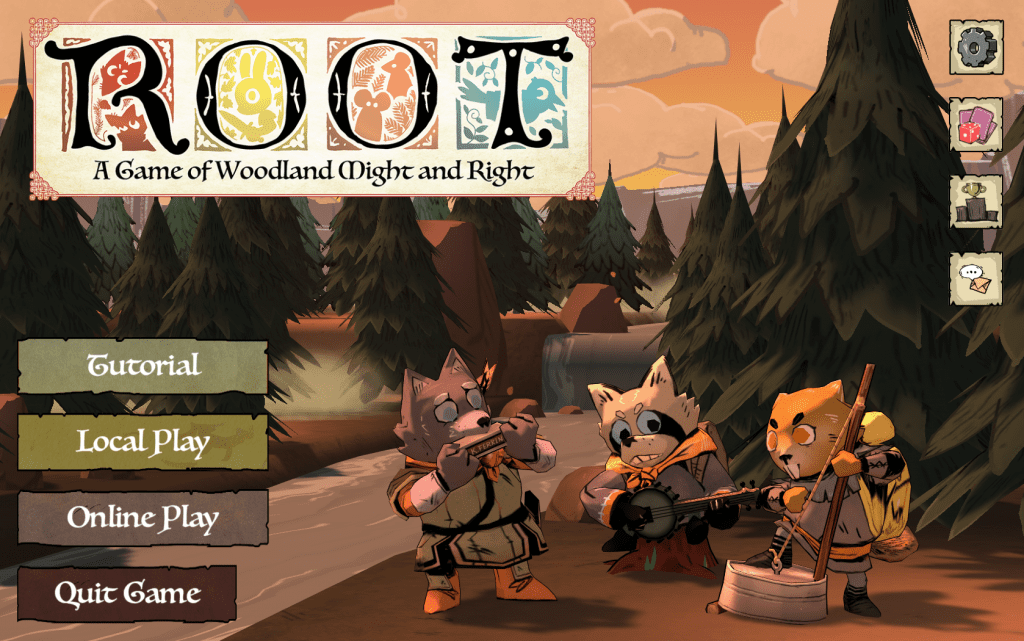
Root is the only game I have ever played where up to four people can sit around the same board and experience up to four entirely different games.
I’m not just talking about asymmetrical abilities like the factions in Terra Mystica or the different companies in Terraforming Mars, nor differing winning conditions as with Vast: The Crystal Caverns. I’m talking about four factions who have a common goal — trying to be the first to score 30 points — but work in completely different ways to achieve that goal.
Sound confusing? Sound like there are lots of rules? Well, yes and yes. But I’m here to help you make sense of them. Because, trust me, Root is definitely worth exploring.
Before I start in on all the differences, let me begin with the three parts of the game all the factions have in common.
Board, Cards, and Battle
As I mentioned in the introduction, each faction carries out their actions on the same game board. In general, these actions take place in the 12 clearings amidst the wooded areas.
Due to the extreme differences in how each faction in Root works, I’m going to be leaning heavily on my thesaurus to find different ways of saying, “In general…” It’s just the nature of the game. For instance…
In general, each faction takes all of their actions either in these groves or traveling the pathway from one grove to the other — with the exception of one who can disappear into the woods at the end of its turn.
Still with me? Good.
Next to each of the 12 clearings is an icon of either a Rabbit, Fox, or Mouse. These relate to the suits on the common deck of cards (The Bird Claw cards are wild, meaning they can be used with any clearing). Each player will get three cards at the start of the game. Many of these cards can be Crafted — that is, activated — provided you have the right kind of structure in a grove that matches the card suit. If a card has duplicate icons, you must have a structure on an equal number of clearings that match the suit.
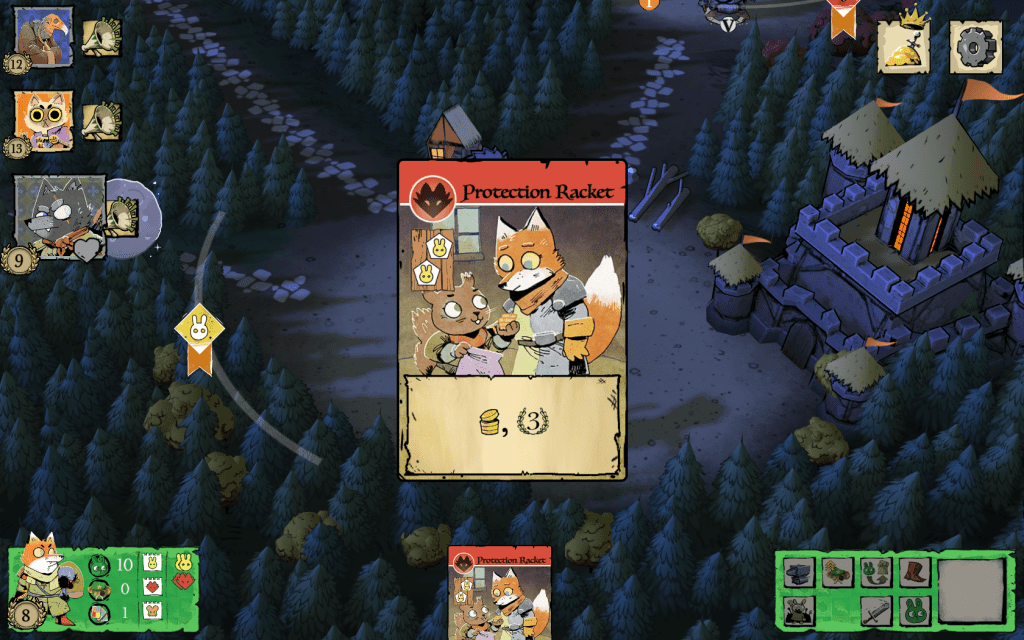
Typically, after Crafting an item the Crafting player will receive the number of points shown on the card or be able to take the stated action. If the Vagabond is playing, Crafting players will also gain the item indicated on the card.
The other type of card you’ll want to consider holding in your hand are the Ambush cards. If someone attacks you in a clearing matching the suit of an Ambush card in your hand, you can play that card and immediately take out two of your opponent’s characters.

In Combat, the attacking player rolls two 12-sided dice with numbers 0-3 on the sides. Most often, the attacker takes the highest number, leaving the defender with the lower number.
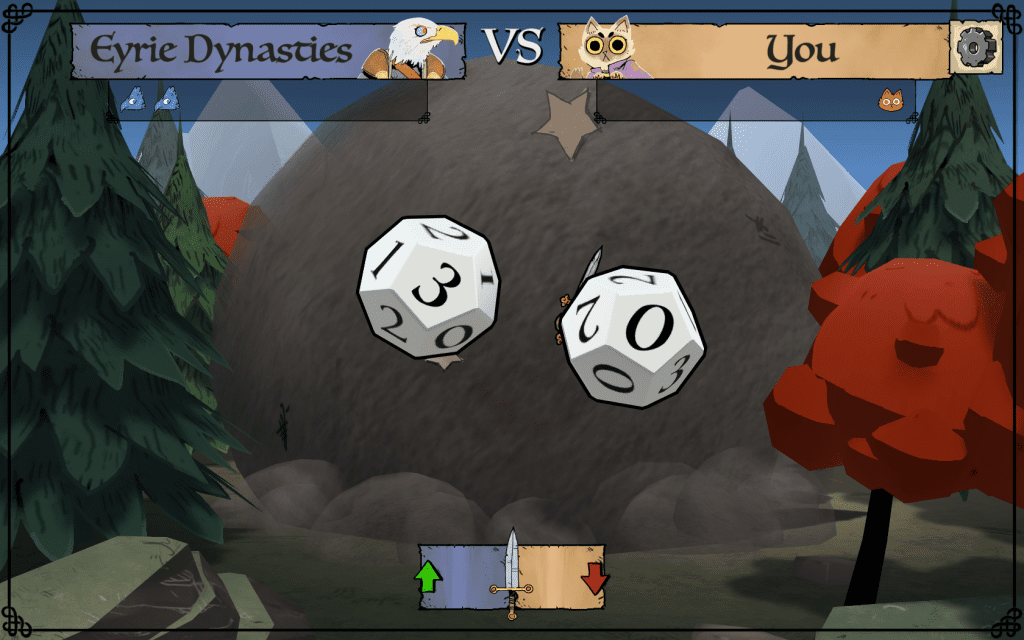
Damage, however, is restricted to the number of warriors you have in the battleground clearing. If you only have two warriors in the clearing and you roll a 3, you’re limited to dealing out 2 damage.
The animated tumbling dice rolls in front of a big dust cloud of commotion keep the Battle aspects of Root off screen and more family-friendly.
Damage is typically dealt out by removing a number of warriors equal to the amount of damage rolled. You can also initiate Combat against defenseless structures belonging to other factions. Defenseless structures are automatically removed from a clearing since they are, well, defenseless.
Common Scoring
All factions score one point for removing a building or another faction’s character from the board as a result of a battle. Whenever a faction Crafts a card, they typically score all the Victory Points listed on the card.
Root Factions
Root is set in a woodland scene of eleven tree areas and twelve groves. No Hundred Acre Woods these, though. The woodland is being contested by up to four disparate groups: The Marquise de Cat, The Eyrie Dynasties, The Woodland Alliance, and The Vagabond. Each group has their own set way of exerting their dominance.
Let’s look at each faction one at a time.
Keep in mind these are brief overviews of each faction. They are by no means a comprehensive description of all actions and abilities of any of the four factions. (After all, this review is long enough as it is!)
Marquise de Cat
The upstart Marquise de Cat seeks to use their abilities to build structures throughout the woodland to establish and maintain their dominance.
As the Marquise de Cat, you will start the game with a Tower in one of the four corners of the woodlands and a Warrior Cat in each grove on the board except for the corner opposite your Tower. Since the Marquise de Cat can only build in a grove where you have the most warriors, this is a great initial advantage — you start by dominating every grove but one!

The Marquise de Cat uses their technological abilities to attempt to rule the forest. At the start of each turn their Sawmills produce wood — wood that is used to build one of three types of buildings: Recruiters, Workshops, or more Sawmills. Each additional building you construct takes an increasing amount of wood but will also score you added points.
Recruiters allow you to bring more of your Cat warriors onto the board. They get placed where a Recruiter has been built. Workshops allow you to Craft cards from your hand, again providing you have a Workshop in a grove whose icon matches the icon on the card. Sawmills allow you to turn wood into more material for more buildings.
After the Sawmills produce wood (one wood per Sawmill) the Marquise de Cat may take up to three of the following actions:
- March: Moving two groups of as many Cat warriors from one clearing to another.
- Recruit: Add one Cat Warrior to each Recruiter’s building.
- Build: Build one of your three types of buildings for which (a) you have sufficient wood to build and (b) an empty space in a clearing where you have the most characters (i.e., more Cats than any other faction has of their creatures).
- Battle: Fight another faction for control of a forest grove.
- Overwork: Spend any one of the cards in your hand whose suit matches a grove where you have a Sawmill. That Sawmill produces an extra wood.
After a Cat warrior falls in battle, the Marquise can play a card of the same suit where the warrior fell to revive the warrior in its Field Hospital. This is conveniently located in the Marquise’s Tower. A revived warrior joins the other Cat warriors in the Tower clearing.
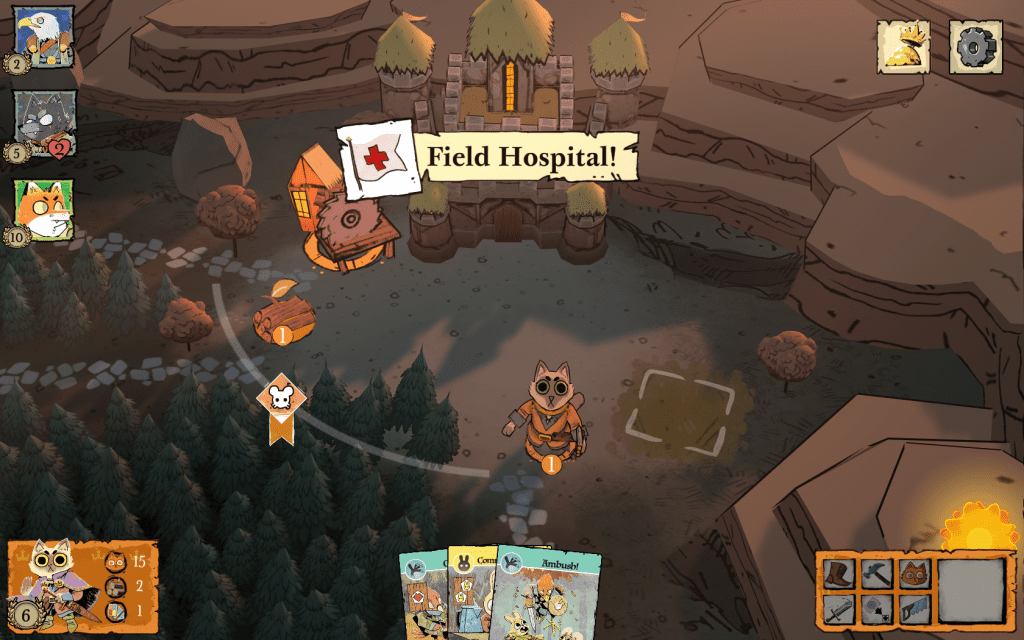
The Marquise de Cat scores points for each building it builds. The more wood it takes to build the building, the more points it scores.
The Eyrie Dynasties
The Eyrie Dynasties once ruled the forest and seek to reclaim their rightful place in the woodlands.
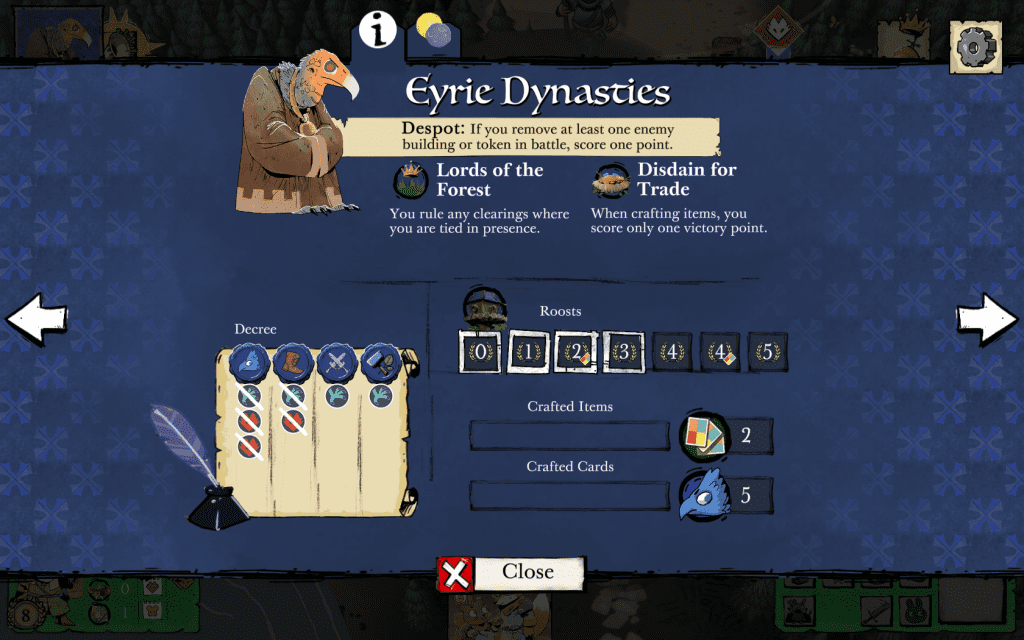
The birds that make up the Eyrie Dynasties are governed by a Decree handed down to them by their Leader. Choosing the Leader you wish to start the game with is your first decision.

The Decree mandates the types of actions they must take each turn of the game. Each Leader has two Viziers who act as the starting cards for the Decree. They are placed in the Decree area as dictated by the Leader’s governing philosophy.
At the start of each turn the Eyrie must add at least one card from their hand to their Decree, thereby increasing their number of mandatory actions each turn.

The four action types within the Decree are:
-
- Recruiting additional Eyrie warriors in clearings where you have built a Roost.
-
- Moving warriors from one area to another.
-
- Engaging in Battle with other factions, and
-
- Building additional Roosts.
The suits of the cards that are added to each action type within the Decree determine where the Eyrie must take those actions. For instance, if a card of any type with a Fox was added to the Move action, on every turn the Eyrie Dynasties must move warriors either into or from a clearing with a Fox icon. As always, Bird-suited cards are wild, meaning they can apply to any of the three animal icons.

It is tempting to stack your Decree with as many Bird cards as possible. This allows you greater flexibility in your options. However, there’s a potential price for using them.
If there ever comes a time when the Eyrie cannot complete an action within their Decree, they go into Turmoil.
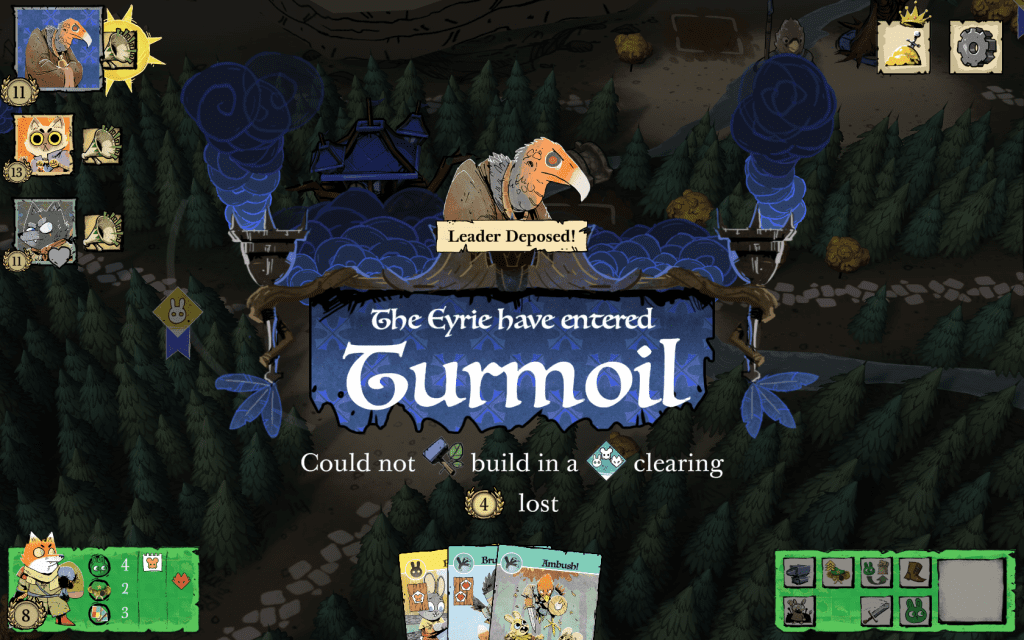
In Turmoil, your turn immediately ends and your current Leader is deposed. All of the cards in the current Decree are discarded. For each Bird card in the Decree, you lose one point. A new Leader is chosen and the two Viziers are placed in the action areas indicated by the new Leader.
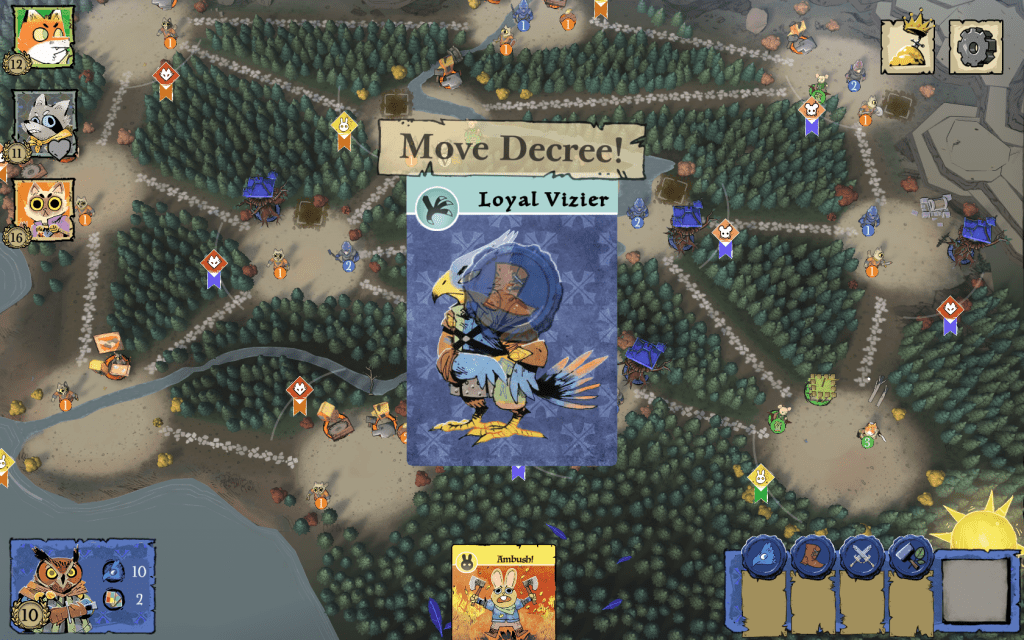
The Eyrie Dynasties scores points for each Roost it has on the board at the end of each turn.
Under most Leaders, they only score one point per Crafted card, regardless of how many points the card indicates.
One of the Challenges in Root is to win the game as the Eyrie Dynasties without going into Turmoil. It’s difficult, but it can be done.
The Woodland Alliance
While the Marquise de Cat and the Eyrie Dynasties are battling for control of the woods, many of the other creatures of the forest have banded together to form The Woodland Alliance. They rely on guerilla tactics and begrudging Tributes paid to them by the other factions to score their points.
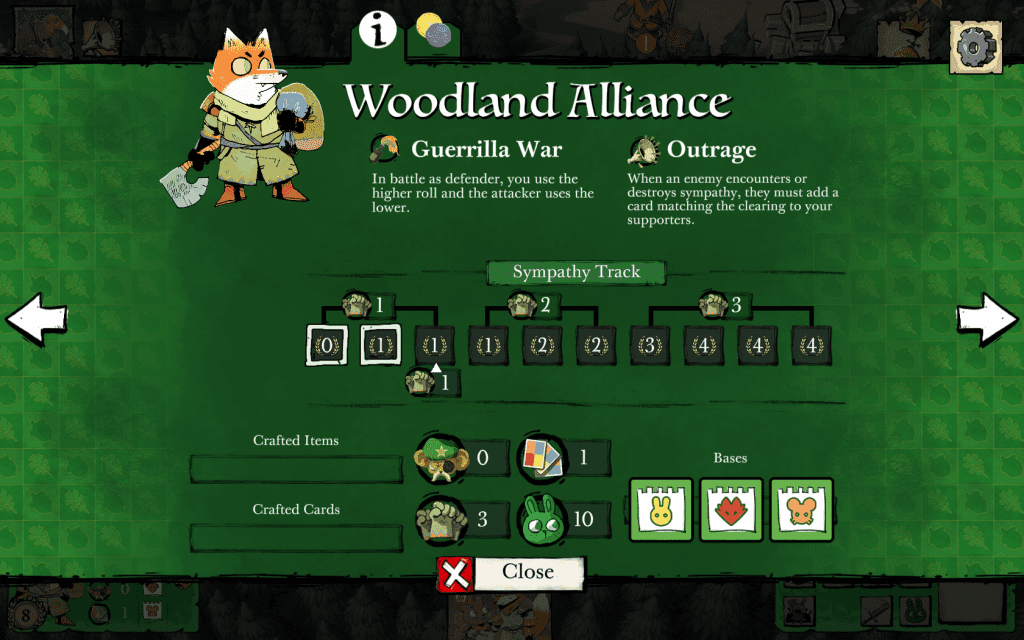
Starting with nothing on the board, The Woodland Alliance uses Supporters to spread Sympathy to forest clearings. To do so, they take standard cards from their Supporters pile, and place Sympathy tokens on clearings that match the suit on their Supporter cards.
Placing Sympathy tokens not only gains you Victory Points but also helps to recruit more Supporters. Any time another faction enters or leaves a clearing where you have Sympathy or removes a token, warrior, or Base from such a clearing, they must give you a card from their hand that matches that clearing’s icon in Tribute. If they have no such matching cards, you get to draw a card off the top of the common pile. That card gets added to your Supporters deck.
Supporters are also used to form a Revolt.

In Revolt, the Woodland Alliance discards two Supporters matching a grove where they already have a Sympathy token. They then place one of their three bases on that clearing. (There are three bases, one for each icon type.) In addition, they remove any and all enemy warriors and buildings in that clearing.
Building Bases increases the number of cards you’ll be able to draw into your hand at the end of each turn. These cards can either be turned into Supporters, Crafted, or discarded to promote a warrior to an Officer.

The number of Officers you have indicates the number of additional actions you can take. These actions include:
- Moving a warrior from one clearing to another.
- Battling an enemy.
- Recruiting a new warrior to a clearing with a Base.
- Organize your troops by replacing a warrior with a Sympathy token (and scoring the appropriate number of points).
One advantage to playing the Woodland Alliance is that due to their underdog status, they always claim the higher number on the dice in Battle. This makes other factions less likely to fight you.
The Vagabond
Despite all the chaos going on in the forest, there is still a lone animal, avoiding much of the commotion and making its way through life on its own terms.
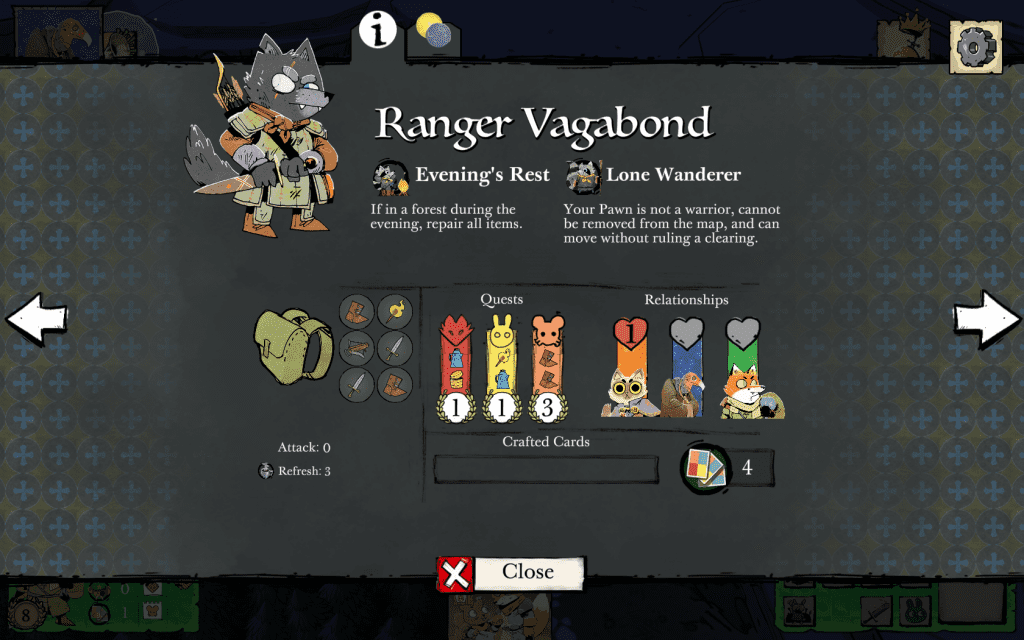
The Vagabond has no interest in ruling clearings, constructing buildings, or joining in revolutions. In fact, instead of starting in a clearing like each of the other factions, The Vagabond starts the game in the woods.

The Vagabond slips from clearing to clearing in search of items found in the woodland ruins. From these items, the Vagabond is able to expand on the number and types of actions it can take on a turn.
Providing you have acquired the right item tokens, the Vagabond can exhaust the item (turn its token over) and take the token’s matching actions:
- Move from one clearing to another.
- Battle with another faction.
- Strike with your crossbow and stealthily eliminate another faction’s warrior.
- Explore an unexplored Ruin in a clearing and claim the item it contains.
- Aid another faction in the same clearing by giving them a card from your hand that matches that clearing. In exchange, you take one of the Crafted item tokens they have.
- Complete a Quest
- Craft a card
- Repair an exhausted item
At the end of your turn the Vagabond, and the Vagabond alone, can disappear into the wooded areas that separate the paths and the woodland groves. There, the Vagabond can repair its exhausted items for reuse on its next turn.
The Vagabond also has the option of Aiding another faction. To do so, the Vagabond must exhaust an item and give another faction a card matching the clearing they are both in. Aiding another faction not only scores Victory Points, but it allows you to take an item from that faction’s board that they gained by Crafting a card with an item listed.

Should you decide to Strike another faction by taking out one of their warriors, you’ll become Hostile with that faction. Striking further warriors or structures for that faction will result in Victory Points.
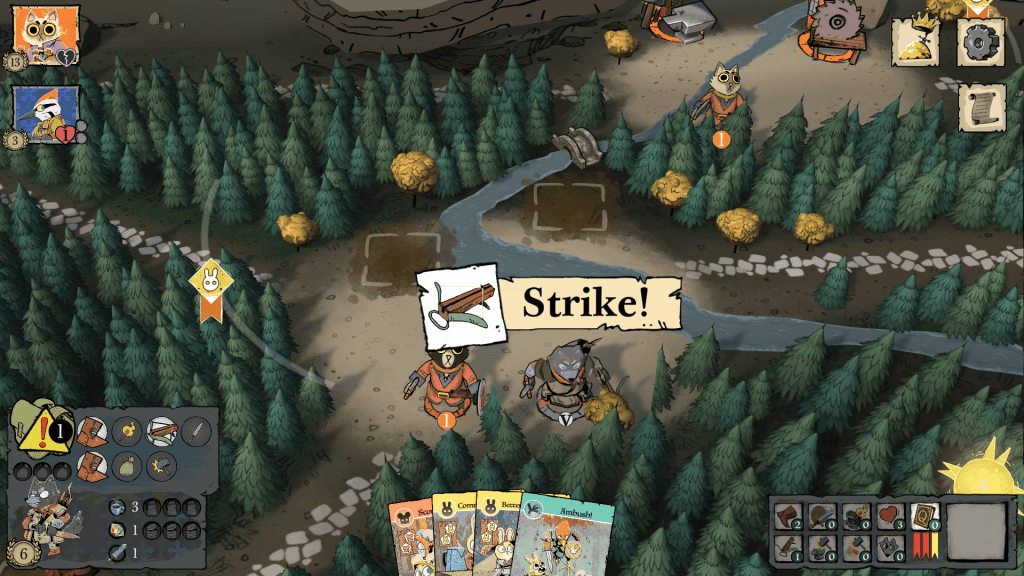
The Vagabond is also able to collect points by completing Quests. Completing a Quest is as simple as having the correct items in your satchel and taking the Complete Quest action.

When The Vagabond takes damage in a Battle, it does not suffer that damage personally. Instead, it must choose a corresponding number of items to prematurely exhaust.
Overall Thoughts
Root is a game that initially baffled me. The factions were so very different that I had a hard time getting my head around how they each worked, much less how to stop another faction from winning.
There were two reasons for this: (a) I was entirely new to the game and (b) the digital game’s tutorials were woefully insufficient for teaching the game. Instead, I took to YouTube and, after watching hours of How to Play videos, I had a far better understanding of the game.
I was willing to invest the time because I had heard very good things about Root. As well, the digital representation of the game was charmingly inviting. I wanted to play a game that struck the right balance between cartoon artwork and a serious strategy game.
In terms of a digital porting of a cardboard and meeples game, Root is both visually appealing and works well. That being said, let’s take a look at some of the other good and some of the frustrating things about the digital version of Root that I found during my many, many hours of playing the game.
The Good
Not only is the artwork clever and inviting, but the animation is smooth and fits each faction. Warriors march through the woods in an orderly way while the trees of the forest sway in the breeze. Before Battles, the two sides appear to size each other up before the fighting begins.

Each faction has a distinct look that works well with the others. In this way, each faction has its own ‘personality’.
Factions also have their own sound effects. You can hear the buzz saws cutting wood during the Marquise de Cat opening moves, for instance, even if you’re looking at a player board. Outrage against the Woodland Alliance and Eyrie recruitment both have their own brief sound effects as well.
As shown earlier, Battles with your faction are announced with a big call-out screen and a momentary pause before the action starts, while the two sides may choose to use an Ambush card if they have one available.
Thankfully, if you’re playing with more than two factions, Battles where you are not involved are resolved quickly behind a brown cloud of dust.
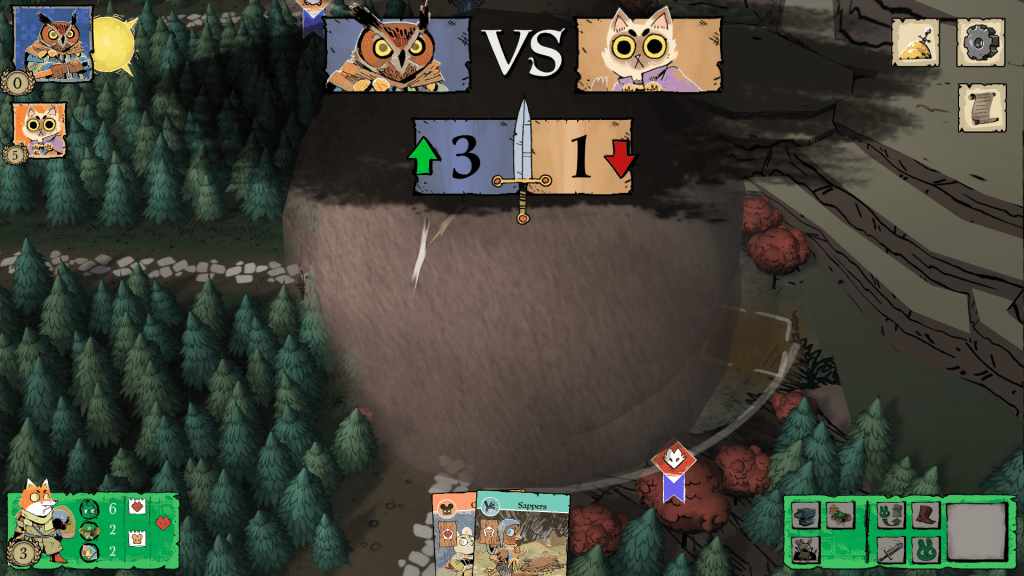
The Frustrating
I’ve already stated that the introductory tutorials are not sufficient to learn how to play Root. These tutorials are presented in a specific order: The Marquise the Cat, Eyrie Dynasties, Woodland Alliance, and The Vagabond. You must go through each of these tutorials in order to learn how to play any of the other factions. This means you cannot go through the Vagabond tutorial without going through the other three first.
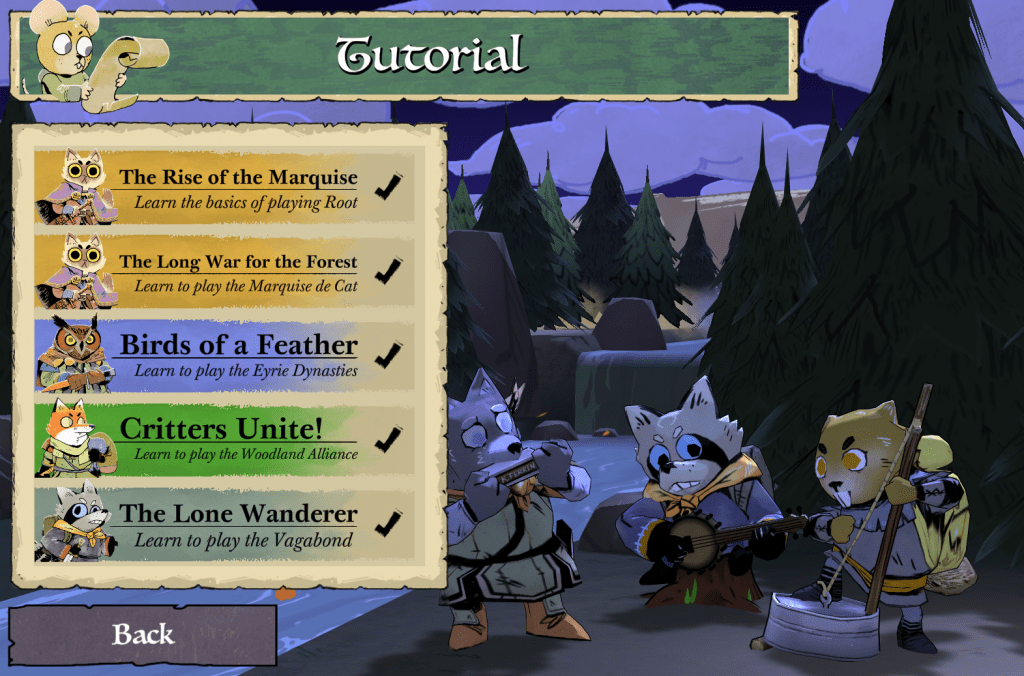
There are better ways of learning how to play Root: either download the rules from BoardGameGeek or dig in to the Settings of the digital game to find them.

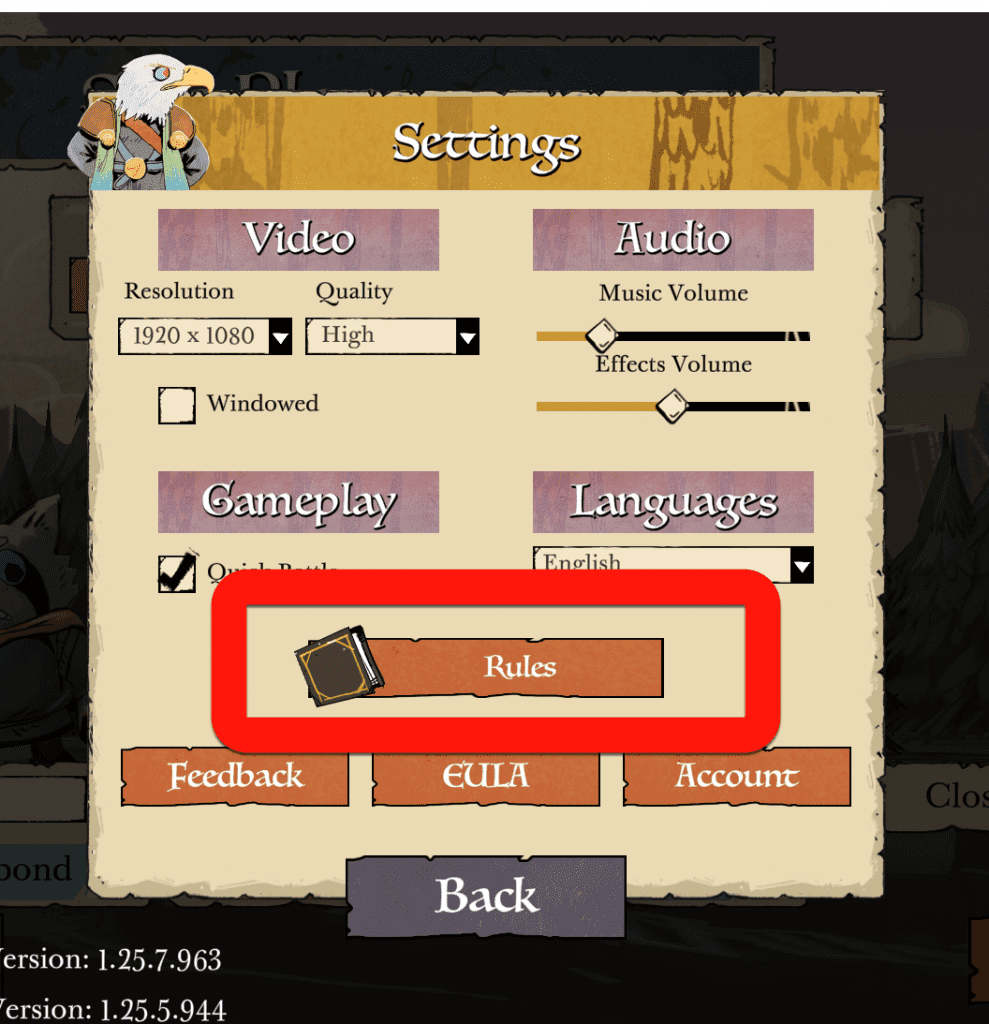
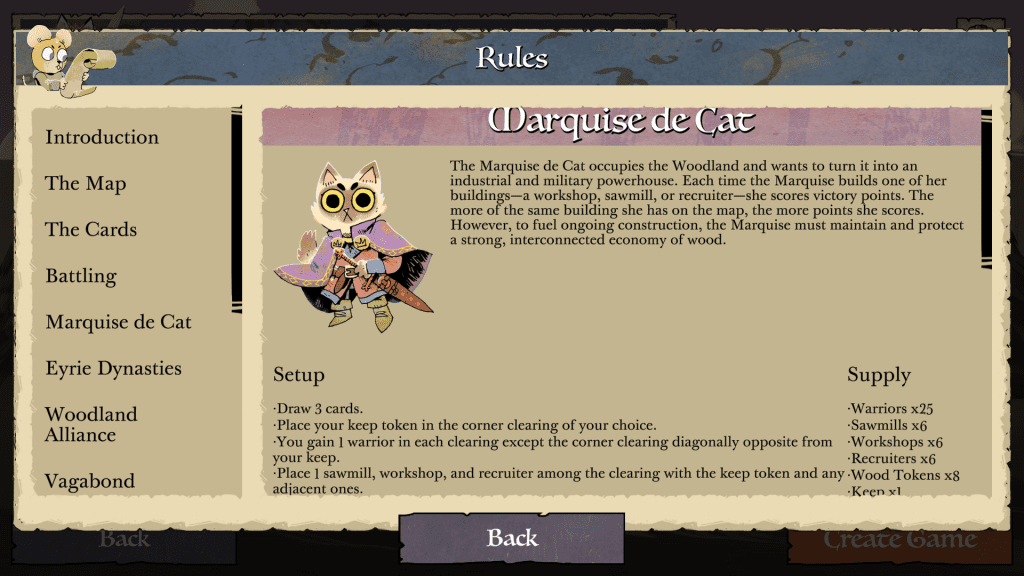
I wish I had found these earlier in my learning process. Instead, I still feel they’re unnecessarily hidden. At least a link to this should be included in the Tutorial sections.
The game’s music, which initially I thought was catchy and befitting the game, became monotonous after a while. There’s only one soundtrack, which changes only with Battles. There are no separate musical themes for each faction, which would have been nice.
There’s a lot of information on the screen, almost too much at times. There is the board, the faction displays to the left of the board (with each faction’s current score), and your own faction’s items, cards, and available actions in the bottom corner. There are times when all of this becomes a bit overwhelming and I’ve had to zoom out to get a better idea of the current state of the game.
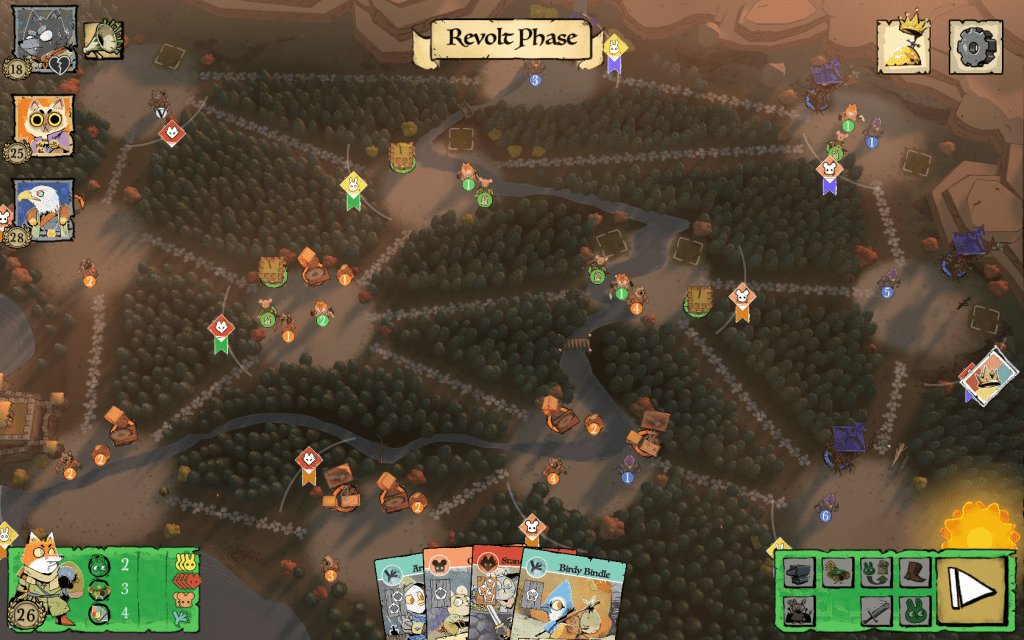
There were other times when I needed to zoom as far out as possible to get a better view of how many warriors from each faction were in each grove.
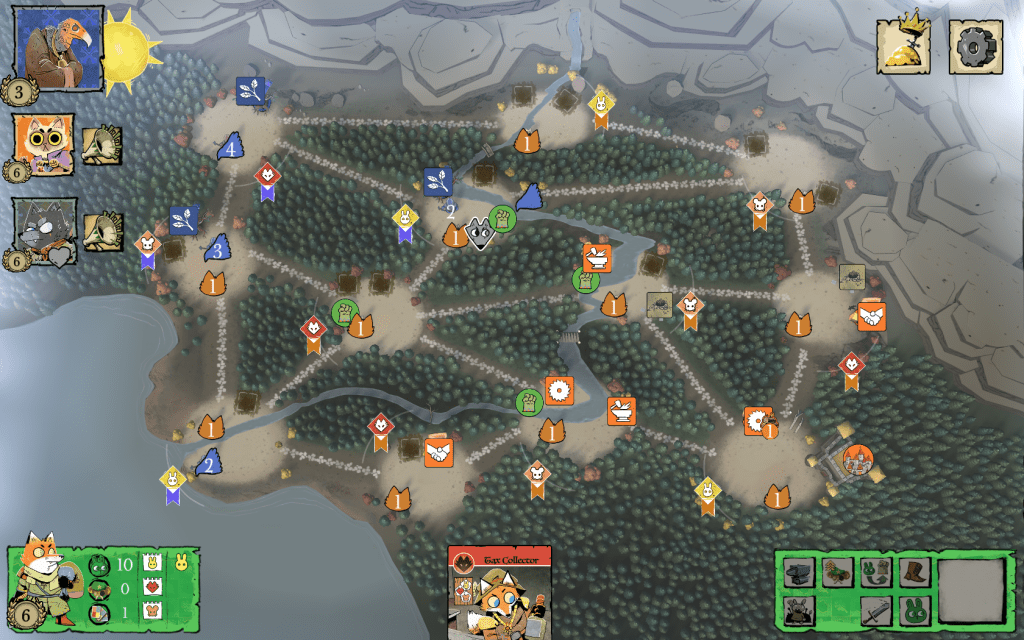
This is especially true when the Eyrie adds to their Decree or enters into Turmoil. A lot of the board is covered by an Eyrie Leader’s banner.

If you (like me) forgot how many Roosts and warriors you had in any of the groves, you have to click and drag the map down to move the map so you can see the groves under the banner.
From a programmatic standpoint, I wish someone would explain to me why you can’t speed up the time it takes the AI to take the turns of the other factions. Similarly, returning to a point I made about the digital version of Terraforming Mars, why isn’t there an Undo option to take back a move? Is this really too much to ask for or expect from a digital version of a board game? It would have been very helpful when I was first learning how to play. (At least the digital version of Scythe offers it as an option that you can turn on or off.)
Final Thoughts
As a board game, Root sits comfortably in the middle ground of worker placement Eurogames. While it doesn’t demand the heavy thinking that Agricola or Tzolk’in do, the scoring moves so quickly that you have to pay attention to the board at all times to determine your best next move.
Root impressed me with how well thought out it was. Designer Cole Wehrle has done a really fine job mixing the disparate factions and their different approaches to scoring victory points. (His designer diary notes are well worth reading.) The game feels well-balanced to me and continually challenging. Admittedly, it took me a while to learn how to play the game as well as play each faction, but I feel it was time well spent.
The digital edition of Root similarly impressed me with its artwork, animation, and approach to the game. In most aspects, it is as well thought out as its cardboard and wooden meeple counterpart. And while there are certainly things I would like to see changed about the digital version, they don’t come close to putting me off of the game. In fact, after watching play-throughs on YouTube, I find I much prefer seeing the animated characters marching from grove to grove and Battles taking place behind huge dust clouds. They make the actions in the physical game look dull in comparison.
If you already know how to play Root but have not yet tried the digital version, I wholeheartedly encourage you to do so. With the ability to choose a faction to play and have the AI play as many other factions as you’d like you’ll find the game challenging for a long while.
Should you be new to Root and the game appeals to you, the digital version is a great way to ease into the game. The Easy AI settings are good for early learning sessions while the Medium and Hard levels will test your skills as you improve.

Root is one of those games that is worthy of the hype. It can be learned in stages, faction-by-faction, allowing players to understand and appreciate how each faction operates and scores and, by extension, how to play against it when taking on another faction.
Speaking of extensions, the physical game already has three expansions which I’m hoping will be ported to the digital realm in time. The digital version has just released the latest, The Clockwork Expansion, meaning there’s already added variety in the gameplay available to long-time players.
Root is firmly in my Always Willing to Play list, even if I’m still really bad at playing some of the factions. (I’m looking at you, Vagabond!)


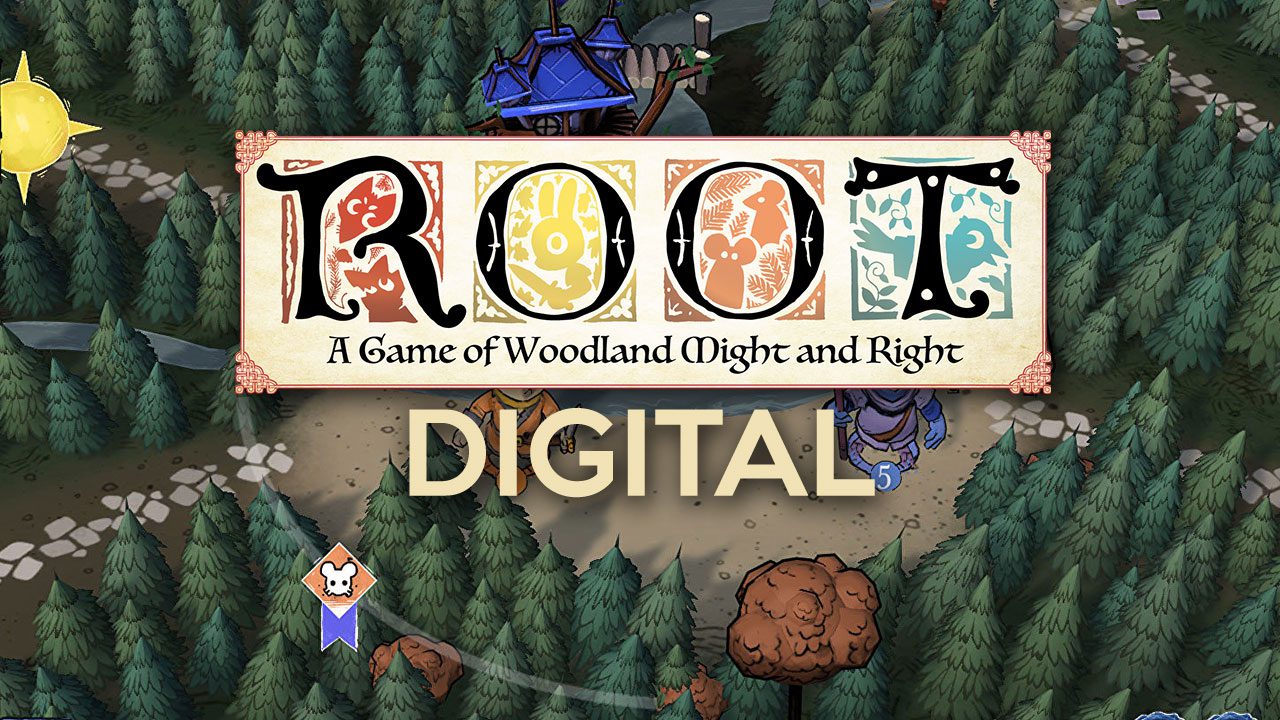



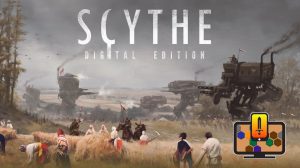
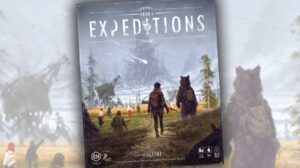




Add Comment